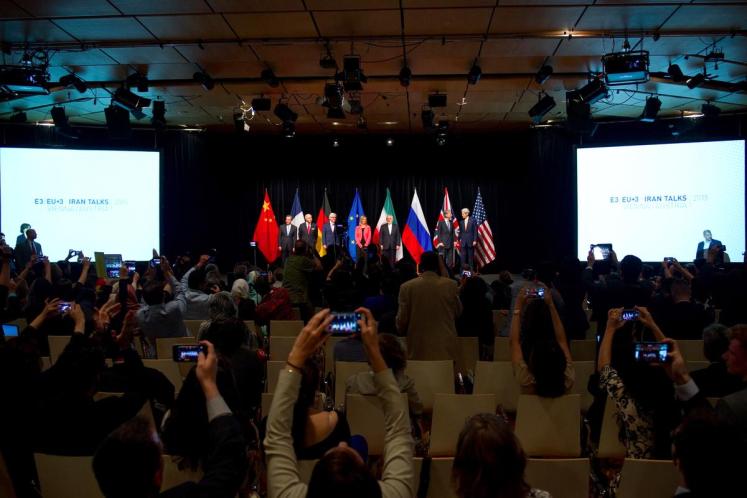The July 14th landmark nuclear agreement between the P5 + 1 – the United States, United Kingdom, Russia, China, France, and Germany – and Iran marks the culmination of a 20-month long negotiation process. Based on the April 2015 framework accord, at the core of the unveiled Joint Comprehensive Plan of Action (JCPOA) is the establishment of strict limits on the Iranian nuclear program in return for the lifting of economic sanctions. The particular character, timing, and sequence of sanctions relief have in fact been a critical component of the talks, with US Secretary of State John Kerry threatening to walk away over the issue as late as July 9th. The surprising level of detail on lifting sanctions in the final JCPOA, “one of the most complex agreements” ever negotiated in the nuclear arena, reveals both the intricacies of the act and the sensitivity surrounding the issue.
Questions about the logistics of sanctions relief surfaced soon after the November 2013 Joint Plan of Action, which expressed that the eventual JCPOA would produce a "comprehensive lifting” of all UN Security Council, multilateral, and national sanctions related to Iran’s nuclear program. The final document suggests a timeframe that aligns more with the Iranian position, with the bulk of the action coming in an initial stage. While not the immediate process demanded by Ayatollah Khamenei, “Implementation Day” will mark the termination (though subject to re-imposition) of provisions in seven Security Council resolutions passed since 2006, contingent upon Iran taking nuclear-related measures to be verified by the International Atomic Energy Agency (IAEA). On that day, the European Union would also lift its oil embargo and unfreeze the assets of Iranian banks, the latter granting Iran immediate access to an estimated $100 billion. Meanwhile, the US would cease to enforce sanctions on non-US persons, lifting restrictions on Iranian oil sales and adjusting its trade embargo to allow the export of civilian aircraft.
Further movement would take place eight years following the official adoption of the JCPOA, or earlier if the IAEA certifies the peaceful nature of the Iranian nuclear program. In conjunction with Tehran seeking ratification of the IAEA Additional Protocol, the United States would mark “Transition Day” by taking legislative action to modify or terminate the statutory sanctions associated with the nuclear program. This language – unique to the US provisions – thus conforms to the position long held by the Obama Administration that sanctions would be “suspended in a phased manner.”1 Meanwhile, the European Union would provide further relief in the financial and transport sectors; the multilateral embargo on ballistic missile trade would be lifted as well.2
Arguably the most interesting aspect of sanctions relief in the JCPOA concerns the dispute resolution mechanism. Any issues regarding Iranian non-compliance would be considered by an established Joint Commission, then subsequently by the ministers of foreign affairs and a three- member Advisory Board if unresolved. Should the complaining participant still not be satisfied, the issue would serve “as grounds to cease performing its commitments under this JCPOA.” In short, each of the P5 + 1 has the legal right to reinstate their individual sanctions regime. Furthermore, the participant could also bring the case to the UN Security Council, which would bring about a vote on a resolution to continue the process of sanctions relief. The absence of such a resolution within 30 days would result in the re-imposition of the old Security Council resolutions. That each of the scenarios seems to preference the “snap back” of sanctions comes as a surprise, and a major win for the P5 + 1 (and the United States in particular).
The consequences of lifting sanctions on Iran’s nuclear program are yet to be determined. Critics of the negotiations have long argued that any sanctions relief would empower Tehran’s regional military ambitions, even allow it to fund terrorist groups. The pace and scope of sanctions relief will be major topics of discussion as each side attempts to sell the deal to their domestic audiences. Regardless, there is no question that the July 14th Joint Comprehensive Plan of Action has provided impressive detail in outlining the procedures for lifting – and potentially re-imposing – the nuclear-related sanctions regime in Iran. That parties created a working group devoted specifically to the implementation of sanctions lifting only underlines the centrality of the issue to the agreement now, and in the months and years to come.
[1] For instance, the US will “cease the application of the sanctions…” on Implementation Day, then “seek such legislative action as may be appropriate to terminate, or modify to effectuate the termination of, the statutory sanctions…” on Transition Day.
[2] While not in the JCPOA text, parties agreed to lift the conventional arms embargo after five years.
Suggested citation: Wilfred Wan., "The Iran Agreement and the Sanctions Question," UNU-CPR (blog), 2015-07-16, https://unu.edu/cpr/blog-post/iran-agreement-and-sanctions-question.


